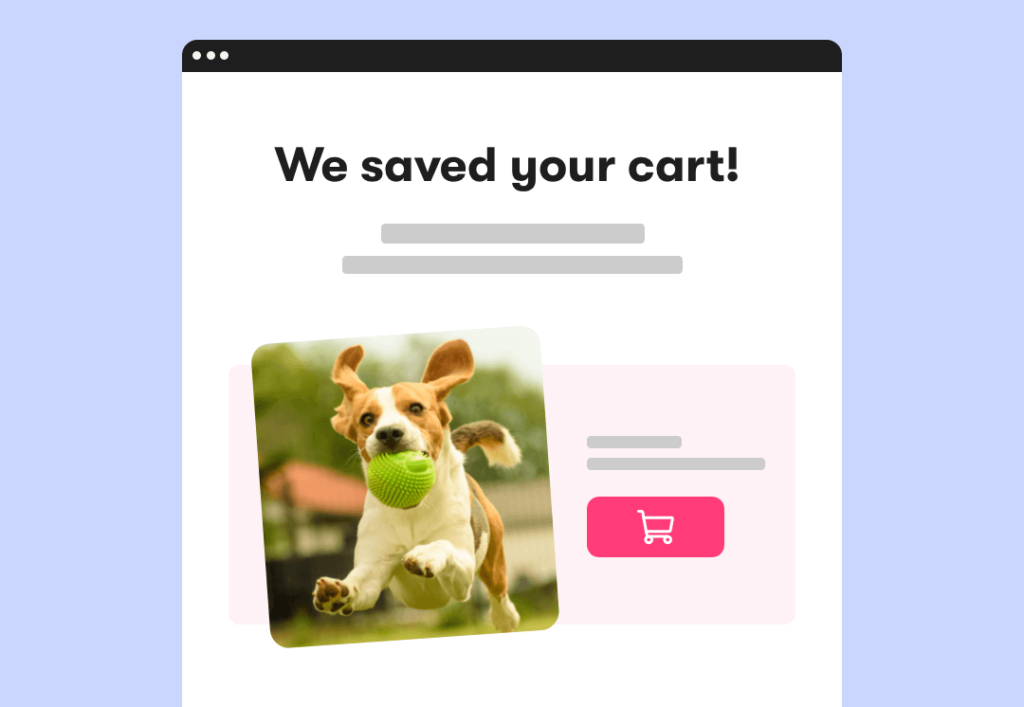To build a successful email campaign for small businesses, the focus should be on building authentic relationships with customers rather than just sending out emails for the sake of it. Staying top of mind is key, but it needs to feel genuine, not forced.
Here’s how to create impactful email campaigns, complete with examples and tips for every occasion.
1. Welcome Email Campaigns for Small Business: Making That First Impression Count
When someone first subscribes to your email list, it’s like the digital equivalent of a handshake—except there’s no risk of clammy palms. This is your chance to introduce your business, establish trust, and show them why you’re worth sticking around for.
Example: If you own a local coffee shop, your welcome email could include a brief story about your passion for coffee and a coupon for their first visit. Make it warm and friendly—think of it like chatting with a neighbor you’ve just met.
Best Practices:
- Subject Line: “Welcome to [Your Business Name]—Here’s Your First Treat!”
- Personalization: Use the recipient’s name to make it feel one-on-one.
- Incentive: A discount or freebie encourages them to engage right away.
2. Event Invitations: Creating Excitement
Hosting events is an excellent way for small businesses to stand out from larger competitors. Whether it’s a special sale, a workshop, or a community event, inviting your customers via email can increase participation and build a sense of community.
Example: If you run a boutique, send out an invite for an exclusive after-hours shopping event with limited spots. Make it sound like a VIP experience to entice people to register.
Best Practices:
- Use an Eye-Catching Subject Line: Something like “Exclusive Event: Shop & Sip with Us!”
- Details Matter: Be clear about the time, date, location, and any perks of attending.
- Include a Call-to-Action (CTA): A button that says “RSVP Now” or “Save My Spot” works wonders.
3. Seasonal or Holiday Promotions: Keeping Things Festive
Seasonal promotions or holiday greetings are a simple way to connect with your customers. Instead of generic greetings, small businesses can add personal touches that larger corporations often miss.
Example: A local bakery could send out an email with a holiday greeting along with a “limited-time” discount on their seasonal treats. Include a message from the owner to make it feel personal, like you’re chatting over coffee.
Best Practices:
- Make It Time-Sensitive: Add urgency with phrases like “Limited-Time Offer” or “Get It Before It’s Gone!”
- Use Festive Imagery: Incorporate visuals that evoke the holiday spirit.
- Personalize the Message: A brief, heartfelt note from the owner can make all the difference.
4. Abandoned Cart Reminders: A Gentle Nudge
If you have an online store, abandoned cart emails are crucial for reminding potential customers of what they left behind. Think of it as a friendly nudge, not a pushy salesman.

Example: If you own a home decor store, send an email that highlights the items left behind, with a message like, “We noticed you left these lovely pieces behind—still interested?” Offer a small discount to encourage them to complete their purchase.
Best Practices:
- Personal Touch: Address the customer by name and mention the specific items left.
- Add Urgency: “Your cart is waiting, but not for long!”
- Incentive: Include a discount code to motivate them to finalize the purchase.
5. Follow-Up After a Purchase or Interaction
Follow-up emails are a powerful tool for strengthening customer relationships. It shows you care beyond the sale, and it can be a great opportunity to ask for feedback or reviews.
Example: After a customer attends a yoga class at your studio, send a thank-you email with a message like, “We loved having you in class! Here’s a code for 10% off your next session.” Encourage them to leave a review if they enjoyed their experience.
Best Practices:
- Gratitude is Key: A simple “thank you” goes a long way.
- Encourage Future Engagement: Offer a discount or link to your social media.
- Ask for Feedback: This shows you value their opinion and helps you improve.
6. Newsletters: Keeping Customers in the Loop
A well-crafted newsletter can be a powerful tool for sharing updates, promoting new products, and maintaining engagement. The trick is to make it valuable and engaging, so it doesn’t feel like just another corporate newsletter.
Example: If you own a local gym, a monthly newsletter could include workout tips, member stories, and upcoming classes. Keep it conversational—like chatting with a gym buddy.
Best Practices:
- Segment Your Audience: Personalize the content based on customer interests or purchase history.
- Keep It Short and Sweet: Focus on the highlights to avoid information overload.
- Visual Appeal: Use images and engaging graphics to break up text and keep it interesting.
7. Re-Engagement Campaigns: Win Back Lost Customers
Sometimes, customers disengage. Maybe they haven’t opened an email in a while or haven’t visited your store lately. A re-engagement campaign can remind them of what they’re missing and encourage them to return.
Example: If you own a salon, send an email saying, “We miss seeing you! Book an appointment this month and get 20% off.” Make it feel personal, like reaching out to an old friend.
Best Practices:
- Make It Personal: Mention how long it’s been since their last visit or purchase.
- Offer an Incentive: A discount or freebie can be the motivation they need.
- Create Urgency: “We’d love to see you again—offer ends soon!”
8. Special Customer Milestones: Show You Care
Celebrating customer milestones like birthdays, anniversaries, or even their first purchase anniversary can create a personal connection and show appreciation.
Example: Send an email to loyal customers on their birthday with a “special birthday treat”—like a discount or a complimentary service. Make it feel exclusive, like a gift from a friend.
Best Practices:
- Personalize: Include their name and mention the specific milestone.
- Use Festive Graphics: Make it feel like a celebration with colorful visuals.
- Incentivize: Offer a discount or freebie that feels like a genuine gift.
9. Educational Emails: Sharing Valuable Information
Small businesses can differentiate themselves by offering educational content that larger competitors might overlook. These emails don’t have to be about your products directly but can provide value that aligns with your brand.
Example: If you run a health food store, send a series of educational emails on topics like “How to Boost Your Immune System Naturally” or “Top 5 Superfoods You Need to Try.” Position yourself as a knowledgeable friend rather than a salesperson.
Best Practices:
- Focus on Value: Provide tips, insights, or resources that benefit the reader.
- Engage with a CTA: Link to your blog or encourage readers to visit your store.
- Keep It Light: Avoid sounding too technical; instead, keep the tone friendly and approachable.
10. Referral Campaigns: Turn Happy Customers into Advocates
Encouraging your existing customers to refer friends is a great way to grow your business. Small businesses have an advantage here because they can add personal touches that feel authentic.
Example: A small coffee shop could send an email saying, “Love our lattes? Share the love! Refer a friend, and you both get a free drink.” Make it feel like an inside deal between friends.
Best Practices:
- Simple and Clear CTA: Make it easy for customers to refer others.
- Offer Dual Rewards: Reward both the referrer and the new customer.
- Personalize: Use the recipient’s name and highlight what they love about your business.
How Skail Can Help Automate Your Email Campaigns Without Losing the Personal Touch
Running a small business means wearing multiple hats, and when it comes to managing email campaigns, those hats can pile up quickly. Crafting personalized, meaningful emails is time-consuming—especially when you want to maintain that special touch that keeps your customers loyal. This is where Skail’s Ai for small business steps in, making it easier for small businesses to scale their email marketing efforts without sacrificing quality or personalization.

Skail is an AI tool designed to create a digital clone of you. It learns your tone, personality, and experiences, allowing it to write emails that sound like they came directly from you. Whether it’s sending a welcome email, following up on abandoned carts, or promoting a seasonal event, Skail can automate the process while maintaining the unique, authentic feel that customers expect from small businesses.
Here’s how Skail does it:
- Personalization at Scale: Skail crafts each email based on your style and customer data, ensuring that every message feels personalized and relevant. Even when sending out bulk emails, each one feels like it’s been thoughtfully written for that particular customer—no more generic blasts that feel impersonal.
- Time Efficiency: By automating your email campaigns with Skail, you save time without compromising the quality of your communication. You set up the campaigns once, and Skail takes care of the rest, executing them as frequently as needed while ensuring every email aligns with your brand’s voice.
- Integration with CRM Systems: Skail seamlessly integrates with popular CRM platforms like HubSpot and Salesforce, allowing you to pull customer data directly into your email campaigns. This integration ensures that every email is not only personalized but also strategically targeted based on your audience’s behaviors and preferences.
- Maintaining Customer Relationships: With Skail, you’re not just automating emails—you’re automating relationship-building. The platform uses the information you provide to write authentic messages that build and nurture customer relationships over time. Whether you’re following up after a meeting, inviting clients to an event, or simply staying in touch, Skail ensures your communications are engaging and genuine.
By using Skail, small businesses can elevate their email marketing efforts, save time, and keep the personal, human touch that makes their business unique. Instead of spending hours crafting each email, you can focus on what you do best—growing your business and engaging with your community—while Skail takes care of the rest.
Final Thoughts
For small businesses, email campaigns are all about building and maintaining relationships. The key is to make every email feel personal and valuable—like a note from a friend rather than a marketing pitch. Remember, it’s not about how often you send; it’s about how well you connect.



